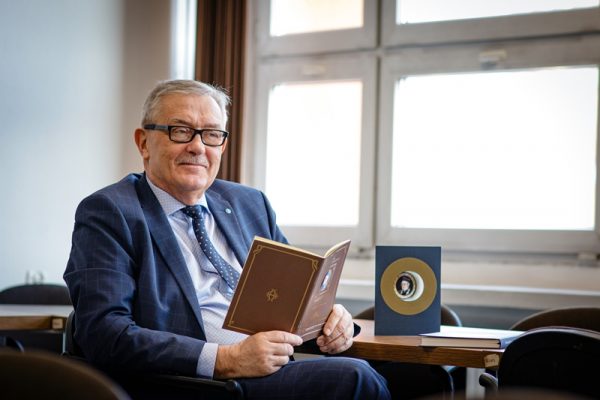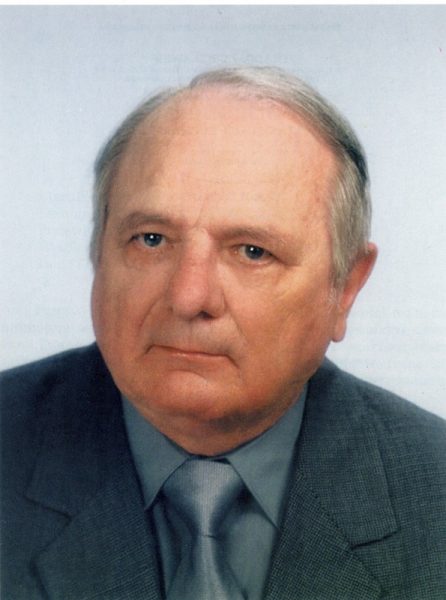Since 2008, the University of Silesia in Katowice has been hosting lectures to commemorate the life and works of Prof. Andrzej Lasota. The scientist, initially associated with the Jagiellonian University, studied physics for two years, and then continued his education at mathematical studies. He wrote his doctoral thesis under the guidance of Prof. Tadeusz Ważewski, founder of Kraków school of differential equations. In 1976, he began to work at the University of Silesia in Katowice. He was a member of the Polish Academy of Sciences and Polish Academy of Arts and Sciences. In 2001, he obtained the honorary doctorate degree at the University of Silesia. His legacy includes numerous scientific publications, concerning e.g. the applications of mathematics. He had many students, collaborators, colleagues and friends who saw him not only as an outstanding mathematician, but also as a great human being. One of his students is Prof. Henryk Gacki, who tells us about his master.
The interview includes fragments of statements made by Prof. Andrzej Lasota,
read by Mirosław Neinert, Director of Korez Theatre in Katowice (in Polish).
|Olimpia Orządała|
History likes to repeat itself – Prof. Tadeusz Ważewski was the master for Prof. Andrzej Lasota, who in turn became the role model for many Silesian mathematicians – he supervised 21 doctors. What was he like for his students and why did he attract them?
I think that this is the most difficult question you could possibly ask me. I would probably give you a totally different answer to it next week, month or year. I was Professor’s student, and then his friend, for many years; I’m also the author of three books about him – and yet, I still don’t think that I know much about him. And this is exactly what Prof. Lasota was like. You cannot close him in any frame, as evidenced by memories of many renowned scholars from around the world, which were included in the book in English edited by myself and published in 2016. To understand whom he was, you need to reject all classic stereotypes about the people of science. He was characterised by unconventionality, huge mathematical and general knowledge, inventiveness, modesty, openness, as well as friendship and love which he shared with his collaborators and students. It was his warmth that was most often remembered during the funeral ceremony.
I remember when we would go shopping after skiing trips. We had our favourite shop in Jeleśnia. I went there on my own shortly after Professor’s death. The shop assistant saw me and asked about my companion. I answered that he had died. There was a moment of silence. And then the shop assistant surprised me by saying: ‘You know, he must have been a great man’. Even the shop assistant, with whom Professor only talked about the weather and shopping, felt that he was dealing with someone unique, although he didn’t know anything about him.
How were you inspired by Prof. Lasota?
First of all, I was fascinated by his huge general knowledge and ability to talk about complex issues using a very simple language. He was capable of presenting difficult theories with straight, properly selected examples. He had a great sense of humour and put anecdotes into his lectures. Thanks to this, we were feeling like his friends during the classes.
I was very proud when he offered me to move to his department after one year’s stay at the Maria Curie-Skłodowska University in Lublin. Thanks to Professor, once I got the doctoral degree, I completely changed my interests and wrote my habilitation thesis on the subject that he proposed. Not only was he my tutor, but also a friend. Our friendship was strengthened, to a certain degree, by our common love for sport.
How did philosophical – or more broadly speaking, humanist – knowledge help Prof. Lasota in his research on mathematics?
Let me quote a Professor’s statement on this subject: ‘Mathematical studies made me aware of constant clear progress, whereas philosophy fascinates me as good literature, allows me to broaden my horizons and stimulates my mind – but it cannot be applied. I must admit that when I was young I did not value humanities as much as I do right now, but I find that they still lack tools, and I like to screw in or repair something even at home – I simply enjoy using tools!’.
Professor highly appreciated philosophical – or more broadly speaking, humanist knowledge. The greatest evidence for this was in his discussions with Prof. Michał Heller, an outstanding philosopher. Humanities allowed him to get a bigger perspective of everything.
How should we understand Prof. Lasota’s words that mathematics is both the most fearful and most beautiful tool at the disposal of a human being?
I think that this question can be answered by Professor’s statement regarding his cooperation with Prof. Maria Ważewska, who was a hematologist: ‘Maria Ważewska was an extremely honest scientist. She had great knowledge in hematology and realised that certain mechanisms in hematology could be described mathematically. At one point, she was lacking tools and told me about these problems. And I would dream about them at night. After a while, I offer her several models and she chose from my ideas what she found to be most interesting from the perspective of biology, which, by the way, frequently drove me to despair. This is because we had to reject several models which were beautiful yet slightly deceitful’.
Despite the initial despair due to false results, the methods of treating children sick with drug-induced anemia were changed thanks to this model. That was extremely important for the Professor: ‘Prof. Ważewska, using by for the planned therapy the differential equation studied by us, significantly helped several patients with drug-induced anemia. If my work contributed to it even to a minimum extent, then perhaps this is the most valuable thing I’ve ever done in my life’.
Prof. Lasota also emphasized that mathematics is the structure of our world and fragment of reality. What’s the application of this discipline in the modern world and how does it affect the reality that surrounds us?
A good example is the above-mentioned cooperation with Prof. M. Ważewska who used the developed model in therapy. They jointly obtained the first class prize in medicine awarded by the Minister of Health. Professor was the only winner in the history of this prize who was not a medical doctor.
On the other hand, the use of huge knowledge related to the theory of differential equations, dynamic systems and physics enabled Prof. Lasota together with Prof. Piotr Rusek to write a paper that helped build a new model of roller-cone drill bit with service life several times longer than the one used back then. Professor was also particularly interested in the theory of fractals which he lectured to his students, showing its connection with art, e.g. based on the example of the cover of the first issue of monograph entitled “Fractals Everywhere” by Michael Barnsley. Thanks to fractals, mathematics and art became as close as never before.
The Andrzej Lasota Lecture has been organised every year for the last dozen years or so. What’s the idea behind it?
Our lecture has become as prestigious as the biggest and oldest mathematical lectures and prizes in Poland, such as Wasław Sierpiński Lecture or Władysław Orlicz Lecture. The most renowned domestic and foreign mathematicians come to Katowice every year. We have hosted e.g. the following professors: Czesław Olech, Michael C. Mackey, Andrzej Pelczar, Lech Górniewicz, Jean Mawhin, Łukasz Stettner, Tien-Yien-Li, Roman Srzednicki, Arrigo Cellina, Aleksander Weron, Piotr Biler. Last year, our invitation was accepted by Prof. James A. Yorke, a winner of Japan Prize. Thanks to this, mathematics is in the limelight in Silesia. It is also worth commemorating people such as Prof. Lasota and talking about his life and works.
Thank you for the interview.
Book published on the occasion of the 80th birthday of Prof. Lasota, edited by Prof. Henryk Gacki (in Polish): www.math.us.edu.pl.
Fragments of statements by Prof. Andrzej Lasota, read by Mirosław Neinert (in Polish):
About Prof. Tadeusz Ważewski as the master:
About fractals:
About mathematics as the structure of the world:
About working with Prof. Piotr Rusek:







